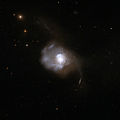Datei:Hubble Interacting Galaxy UGC 8058 (2008-04-24).jpg

Größe dieser Vorschau: 600 × 600 Pixel. Weitere Auflösungen: 240 × 240 Pixel | 480 × 480 Pixel | 768 × 768 Pixel | 1.024 × 1.024 Pixel | 2.363 × 2.363 Pixel
Originaldatei (2.363 × 2.363 Pixel, Dateigröße: 5,81 MB, MIME-Typ: image/jpeg)
Dateiversionen
Klicke auf einen Zeitpunkt, um diese Version zu laden.
| Version vom | Vorschaubild | Maße | Benutzer | Kommentar | |
|---|---|---|---|---|---|
| aktuell | 23:47, 27. Apr. 2008 |  | 2.363 × 2.363 (5,81 MB) | とある白い猫 | {{Information |Description=The extraordinary galaxy UGC 8058, also known as Markarian 231, was discovered in 1969 as part of a survey searching for galaxies with strong ultraviolet radiation. It has long tidal tails and a disturbed shape. Results from the |
Dateiverwendung
Die folgende Seite verwendet diese Datei:
Globale Dateiverwendung
Die nachfolgenden anderen Wikis verwenden diese Datei:
- Verwendung auf ar.wiki.x.io
- Verwendung auf el.wiki.x.io
- Verwendung auf en.wiki.x.io
- Verwendung auf fr.wiki.x.io
- Verwendung auf id.wiki.x.io
- Verwendung auf ja.wiki.x.io
- Verwendung auf nl.wiki.x.io
- Verwendung auf nn.wiki.x.io
- Verwendung auf no.wiki.x.io
- Verwendung auf pl.wiki.x.io
- Verwendung auf pt.wiki.x.io
- Verwendung auf ru.wiki.x.io
- Verwendung auf sv.wiki.x.io
- Verwendung auf tr.wiki.x.io
- Verwendung auf www.wikidata.org
- Verwendung auf zh.wiki.x.io